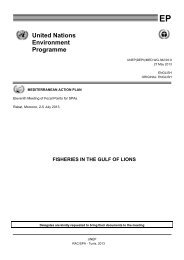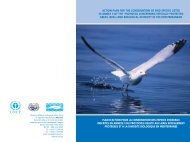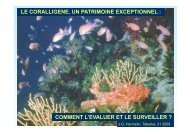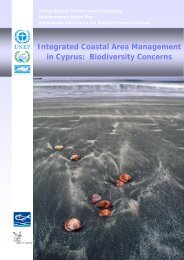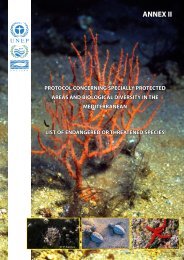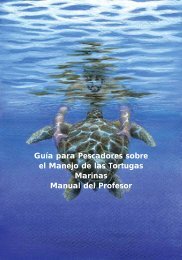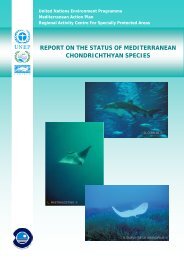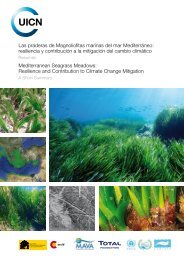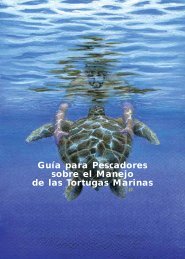Proceedings of the Second Mediterranean Symposium on Marine
Proceedings of the Second Mediterranean Symposium on Marine
Proceedings of the Second Mediterranean Symposium on Marine
You also want an ePaper? Increase the reach of your titles
YUMPU automatically turns print PDFs into web optimized ePapers that Google loves.
While <str<strong>on</strong>g>the</str<strong>on</strong>g> <str<strong>on</strong>g>Mediterranean</str<strong>on</strong>g> Sea <strong>on</strong>ly represents less than 0.8% <str<strong>on</strong>g>of</str<strong>on</strong>g> <str<strong>on</strong>g>the</str<strong>on</strong>g> total area <str<strong>on</strong>g>of</str<strong>on</strong>g> <str<strong>on</strong>g>the</str<strong>on</strong>g><br />
world's oceans and less than 0.3% <str<strong>on</strong>g>of</str<strong>on</strong>g> <str<strong>on</strong>g>the</str<strong>on</strong>g>ir volume, its macrophyte (i.e., hereafter,<br />
pluricellular Plantae, Chromobi<strong>on</strong>ta and Cyanobacteria) epsil<strong>on</strong> species diversity<br />
represents 12% <str<strong>on</strong>g>of</str<strong>on</strong>g> <str<strong>on</strong>g>the</str<strong>on</strong>g> world's described species, with c<strong>on</strong>spicuous differences according<br />
to <str<strong>on</strong>g>the</str<strong>on</strong>g> c<strong>on</strong>sidered taxa (e.g. 17% for Fucophyceae, Chromobi<strong>on</strong>ta) (Ribera et al., 1992;<br />
Boudouresque, 1997).<br />
It does not appear to be <str<strong>on</strong>g>the</str<strong>on</strong>g> case that what we see is an artefact linked to <str<strong>on</strong>g>the</str<strong>on</strong>g> intensity<br />
<str<strong>on</strong>g>of</str<strong>on</strong>g> scientific investigati<strong>on</strong> being greater than for o<str<strong>on</strong>g>the</str<strong>on</strong>g>r regi<strong>on</strong>s <str<strong>on</strong>g>of</str<strong>on</strong>g> <str<strong>on</strong>g>the</str<strong>on</strong>g> world (Fig. 6): larger<br />
seas, with greater intensity <str<strong>on</strong>g>of</str<strong>on</strong>g> scientific investigati<strong>on</strong> than in <str<strong>on</strong>g>the</str<strong>on</strong>g> eastern <str<strong>on</strong>g>Mediterranean</str<strong>on</strong>g><br />
(e.g. <str<strong>on</strong>g>the</str<strong>on</strong>g> Gulf <str<strong>on</strong>g>of</str<strong>on</strong>g> Mexico, <str<strong>on</strong>g>the</str<strong>on</strong>g> south-eastern coast <str<strong>on</strong>g>of</str<strong>on</strong>g> USA and <str<strong>on</strong>g>the</str<strong>on</strong>g> Caribbean Sea) show a<br />
much lower epsil<strong>on</strong> species diversity (Fig. 6; Boudouresque, 1997).<br />
Fig. 6. Epsil<strong>on</strong> species diversity <str<strong>on</strong>g>of</str<strong>on</strong>g> macrophytes (i.e. pluricellular Plantae, Chromobi<strong>on</strong>ta and Cyanobacteria):<br />
number <str<strong>on</strong>g>of</str<strong>on</strong>g> species versus surface area (x 1000 km2) <str<strong>on</strong>g>of</str<strong>on</strong>g> <str<strong>on</strong>g>the</str<strong>on</strong>g> biogeographic regi<strong>on</strong>s. From Boudouresque<br />
(1997).<br />
ACTES DU DEUXIEME SYMPOSIUM MEDITERRANEEN SUR LA VEGETATION MARINE (ATHENES, 12-13 DECEMBRE 2003)<br />
41




